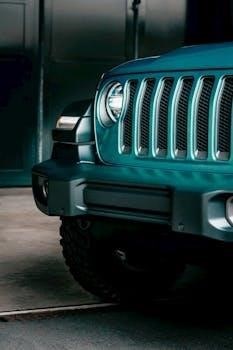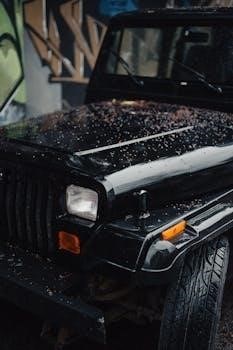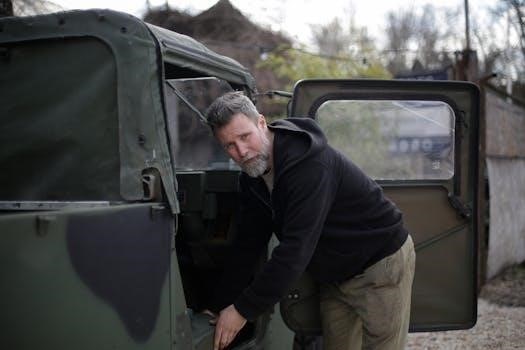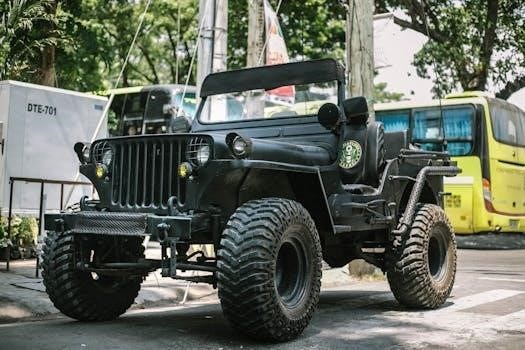
Understanding Flat Towing
Flat towing, also known as four-down towing, involves pulling a vehicle behind another with all four wheels on the ground. For a Jeep Wrangler with a manual transmission, this requires specific preparation to prevent damage. It is important to follow the correct procedure to ensure a safe and successful tow.
What is Flat Towing?
Flat towing, often referred to as four-down towing, is a method of towing a vehicle behind another where all four wheels of the towed vehicle remain on the ground. This contrasts with methods like dolly towing or trailer towing, where some or all of the towed vehicle’s wheels are off the ground. The key aspect of flat towing is that the towed vehicle’s wheels rotate freely, which allows it to follow the path of the towing vehicle. When flat towing a manual transmission Jeep Wrangler, it is essential to ensure the transfer case is in neutral to disengage the driveline from the wheels. Additionally, the manual transmission must be placed in a specific gear for lubrication purposes, which is a critical step to prevent damage to the transmission while towing. It is important to adhere to the manufacturer’s recommended procedure to avoid potential issues.
Why Flat Tow a Jeep Wrangler?
Flat towing a Jeep Wrangler, particularly one with a manual transmission, is a popular choice for recreational vehicle (RV) owners. The Wrangler’s robust build and design make it well-suited for this type of towing, offering the flexibility to explore off-road trails once the RV is parked. Flat towing is convenient as it eliminates the need for a trailer, saving space and reducing overall length when traveling. Moreover, many Jeep Wranglers are specifically designed to be flat-towed, which simplifies the process. For manual transmission models, proper preparation is crucial, involving shifting the transfer case into neutral and placing the transmission in gear for lubrication. This allows the transmission components to receive adequate lubrication as the wheels turn during towing. This ensures that the vehicle is towed safely and without causing unnecessary wear or damage.

Preparing Your Jeep Wrangler for Flat Towing
Proper preparation is key for flat towing a manual Jeep Wrangler. This involves specific steps to ensure the driveline is disengaged and the transmission is lubricated to prevent damage during towing.
Transfer Case Positioning
The transfer case is a critical component when preparing your manual Jeep Wrangler for flat towing. It is essential to shift the transfer case into the Neutral (N) position. This action disengages the driveline, allowing the wheels to rotate freely without turning the engine or the transmission. Failure to correctly place the transfer case in neutral will cause damage to your vehicle as it is being towed. The transfer case is what will allow the wheels to spin freely. After shifting into neutral, ensure the 4WD light is off. It’s also a good idea to move the vehicle slightly forward and backward to confirm that the axles are fully disengaged. This step prevents binding and ensures that the towing process is smooth and safe. The transfer case neutral position is crucial to isolate the transmission from the wheels during the flat tow.
Manual Transmission Gear Selection
After placing the transfer case in neutral, the next crucial step is selecting the correct gear for your manual transmission. Contrary to what one might expect, the manual transmission should NOT be left in neutral during flat towing. Instead, it should be placed in a specific gear; many recommend using second gear. This is vital for proper lubrication of the transmission components. When the transmission is in gear, the internal parts rotate, allowing oil to circulate and provide lubrication. If left in neutral, the transmission’s internal parts may not receive adequate lubrication while the vehicle is being towed, potentially leading to overheating and damage. Confirm the transmission is securely in the chosen gear. This specific gear selection is essential to maintaining the health of your manual transmission during flat towing.
The Importance of Gear Selection for Lubrication
The primary reason for selecting a specific gear in a manual transmission during flat towing is to ensure proper lubrication. When the transfer case is in neutral, the vehicle’s wheels are free to rotate. If the manual transmission is also left in neutral, the internal components of the transmission won’t rotate sufficiently to circulate the lubricating oil. This lack of lubrication can cause friction and excessive heat, potentially leading to severe damage. By engaging a gear, typically second, the transmission’s shafts and gears are forced to rotate with the wheels. This rotation allows the transmission oil to splash and reach all the necessary parts, providing the lubrication required to prevent damage during towing. Therefore, correct gear selection is not just a procedural step but a critical factor in maintaining the integrity of the manual transmission during flat towing.

Step-by-Step Flat Towing Procedure
Proper flat towing requires careful setup. This includes correctly positioning the transfer case, selecting the appropriate manual transmission gear, and ensuring all connections are secure. Safety checks are essential before beginning your journey.
Initial Setup and Checks
Before you begin flat towing your Jeep Wrangler with a manual transmission, several crucial steps must be completed. First, ensure that the Jeep is on a level surface and that the parking brake is firmly engaged. Next, with the engine running, depress the brake pedal and the clutch pedal. Shift the transfer case into the Neutral (N) position; confirm that the 4WD light goes out to verify proper disengagement. Then, shift the manual transmission into gear, typically second or third, to provide lubrication during towing. After this step, turn the engine off, and place the key in the accessory (ACC) position, ensuring the steering wheel is unlocked. Finally, double-check all connections of your towing equipment and verify that your Jeep is securely attached to the tow vehicle. These preliminary checks are critical for a safe towing experience and to prevent damage to the vehicle’s drivetrain.
Finalizing the Connection
Once the initial setup and checks are complete, the next step is to finalize the connection between your Jeep Wrangler and the towing vehicle. Begin by ensuring the tow bar is properly attached to both the Jeep and the towing vehicle, verifying that all pins and locking mechanisms are secure. Connect the safety cables or chains, crossing them under the tow bar to prevent the towed vehicle from separating if the main connection fails. Then, plug in the wiring harness for the lights, ensuring that the brake lights, turn signals, and running lights are all functional on the towed Jeep. After these connections are complete, perform a thorough visual check of all components, confirming that everything is securely in place. It is important to make sure that there is no binding or restriction in the movement of the tow bar. Finally, release the parking brake on the Jeep before beginning to tow. These final steps are crucial for a safe and successful flat towing experience.
Safety Considerations While Towing
Safety is paramount when flat towing a Jeep Wrangler, especially one with a manual transmission. Before each trip, double-check all connections, including the tow bar, safety cables, and electrical wiring. Ensure the Jeep’s tires are properly inflated to the recommended pressure, and that the steering wheel is unlocked and able to move freely. During the tow, make smooth and gradual movements, avoiding sudden stops or sharp turns that could cause instability. Regularly check the towed vehicle in your mirrors to ensure it is tracking correctly and that no issues have arisen. It’s also vital to be aware of any weight restrictions and speed limits associated with flat towing. Be mindful of the increased length of your vehicle combination, allowing for additional stopping distance and wider turns. If possible, use a supplemental braking system on the towed vehicle for increased safety, particularly in emergency situations. Finally, if you feel any unusual movement or hear strange noises while towing, pull over immediately to inspect all connections and components.

Additional Information
Flat towing a Jeep Wrangler manual transmission requires careful attention to detail. Understanding key positions, differences in transmissions, and common mistakes is crucial for a safe and successful towing experience. Always refer to your owner’s manual for model-specific instructions.
Key Position and Steering Wheel
When flat towing a Jeep Wrangler with a manual transmission, the position of the ignition key is critical for proper steering. The key should be placed in the ‘ACC’ (accessory) or unlocked ‘OFF’ position. It is paramount that you never use the ‘LOCK’ position, as this will engage the steering wheel lock, preventing the front wheels from turning freely, which is essential for safe towing. This lock could cause significant damage to the steering mechanism and be a dangerous situation. Ensuring the key is in the correct position allows the steering wheel to rotate as the tow vehicle makes turns, enabling the Jeep to track correctly behind. Furthermore, make sure the steering wheel is free to move; verify this by turning it slightly left and right before you begin towing. Double-check that the steering is not locked before you start your journey. This simple step will help avoid potential accidents and ensure a smooth and worry-free tow. This step is extremely important.
Differences Between Automatic and Manual Transmissions
The key difference between flat towing a Jeep Wrangler with an automatic transmission versus a manual transmission lies in how the transmission is prepared for towing. For a manual transmission, after shifting the transfer case to neutral, you must then place the manual transmission into a gear. This allows the transmission to be lubricated during the tow, preventing internal damage. With an automatic transmission, the procedure involves shifting the transfer case into neutral, and then the transmission should be left in park, which will keep the automatic transmission from turning during the tow. In contrast, automatic transmissions, if not in park can have damage. The manual needs to be placed into a gear to allow for proper oil circulation, which prevents overheating, and damage. While both require the transfer case to be in neutral for flat towing, the handling of the main transmission is different, thus the potential for internal damage is different between the two types. So this is why you must always ensure you are following the correct procedure for your transmission type.
Common Mistakes to Avoid
One of the most common mistakes when flat towing a manual Jeep Wrangler is neglecting to put the manual transmission in gear after shifting the transfer case into neutral. This seemingly simple step is crucial for lubrication; leaving the manual transmission in neutral will lead to significant internal damage. Another frequent error is not ensuring that the key is in the correct position. The key should be in the accessory or unlocked off position, depending on your vehicle’s year. Failing to do so can lock the steering wheel, making it impossible to maneuver safely. It is also a mistake to forget to disconnect any supplemental braking systems before driving after the tow. Also, not performing a check on all the connections before towing is a major mistake. Always double check the tow bar and safety chains. Neglecting these steps will lead to damage or an unsafe tow. Finally, relying on anecdotal information instead of consulting the Jeep owner’s manual should be avoided.

Leave a Reply
You must be logged in to post a comment.